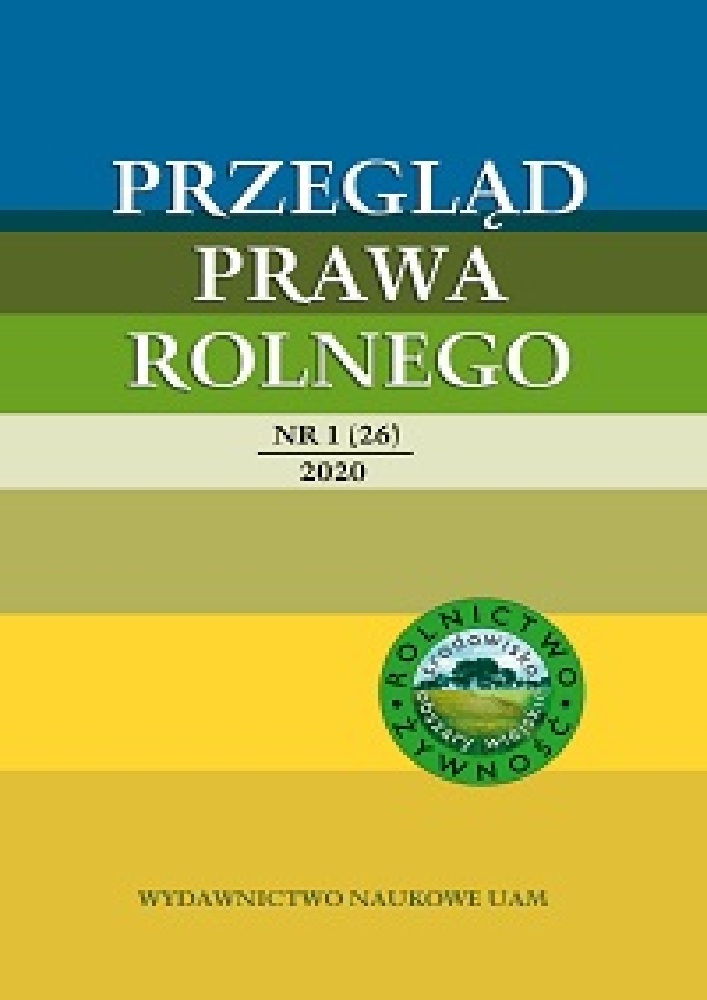Abstract
The considerations concern the applicability of the provisions of the Act on shaping the agricultural system to the legal regulations of agriculture contained in the civil code. The focus is on the inheritance of agricultural holdings, as well as the division of inheritance consisting of an agricultural holding, the abolition of joint ownership of an agricultural holding and the division of joint property of spouses, taking into account the provisions of the Act on shaping the agricultural system. The intention of the legislator was to ensure protection of agricultural land also in the scope of trading in agricultural real estate that has been provided for in the civil code. However, there are doubts regarding the interpretation of the terms used in both legislative acts as it leads to certain differences in the understanding of institutions defined in the code. However, this is an unacceptable situation and the provisions of special laws must not change the legal definitions of agricultural institutions guaranteeing agricultural property. This way of "amending" the civil code results in the inconsistency and dysfunctionality of the legal system.
References
Banaszkiewicz B., Pięta A. (1989), Praca w gospodarstwie rolnym jako przesłanka szczególnej zdolności do nabycia własności nieruchomości rolnej, „Palestra” nr 1.
Bieranowski A. (2016), Dekompozycja konstrukcji zasiedzenia w nowym reżimie ograniczeń nabycia własności nieruchomości rolnej – zagadnienia węzłowe i uwagi de lege ferenda, „Rejent” nr 5.
Błażejczyk M. (1990), Ustrojowe podstawy i kierunkowe założenia programu rolnego w świetle traktatowych zasad polityki rolnej EWG ustanowionych w I Trattato di Roma della politica agricola comune, Wrocław.
Lichorowicz A. (1991), Podstawowe rozwiązania w zakresie obrotu gruntami rolnymi w ustawodawstwie krajów Europy Zachodniej, „Studia Prawnicze” z. 3.
Lichorowicz A. (2001), Szczególny porządek dziedziczenia gospodarstw rolnych w Polsce po orzeczeniu Trybunału Konstytucyjnego z dnia 31 I 2001 r., „Rejent” nr 9.
Habdas M., Fras M. (red.) (2017), Kodeks cywilny. Komentarz, t. II, Warszawa.
Pańko W. (1984), O prawie własności i jego współczesnych funkcjach, Katowice.
Paździk R., Dudzic A. (2002), Nabywanie nieruchomości w Polsce przez osoby fizyczne i prawne z Unii Europejskiej (uwagi na tle stanowiska negocjacyjnego), „Rejent” nr 12.
Pisuliński J. (2016), O niektórych osobliwościach obrotu nieruchomościami rolnymi, „Rejent” nr 5.
Ptaszyk M. (1991), Nowe zasady obrotu nieruchomościami rolnymi inter vivos, „Państwo i Prawo” z. 7.
Stańko M. (2017), Pojęcie nieruchomości rolnej w kodeksie cywilnym i ustawie o kształtowaniu ustroju rolnego, „Studia Iuridica Agraria” t. 15.
Stefańska K. (1992), Model indywidualnego gospodarstwa rolnego w świetle znowelizowanego kodeksu cywilnego, „Państwo i Prawo” z. 3.
Wójcik S. (1983), Przeniesienie własności nieruchomości rolnej między osobami fizycznymi w świetle zmian kodeksu cywilnego, „Nowe Prawo” nr 1.
License
According to the policy of implementing the CC license at the Adam Mickiewicz University in Poznań and the conditions set out in the license for works with the obligation to grant CC sublicenses.
ARTICLES ARE LICENSED UNDER A CREATIVE COMMONS:






